In this article, I will be covering all tips and tricks on how to stick to OMAD in the long run. Once you already doing one meal a day, and you probably starting to see some good results, you may be wondering how to stick to the plan?

Any form of extended intermittent fasting it’s gonna be challenging, especially for beginners. Because in the western world we are not used to not eating for so long. So eating one meal a day may feel doubting in the long-term.
So here are my best tips on how to stick to OMAD in the long term.
How To Stick To OMAD
One of the most common problems people have with adapting to OMAD is the temptation, cravings, and appetite for a range of foods. This is normal.
Everyone has those moments. Even on a daily basis. I used to crave sweet foods when I was on OMAD. And if got to the point that all I could think of was food.
To fight those cravings you use a simple self-assessment technique, a scale of one to ten.
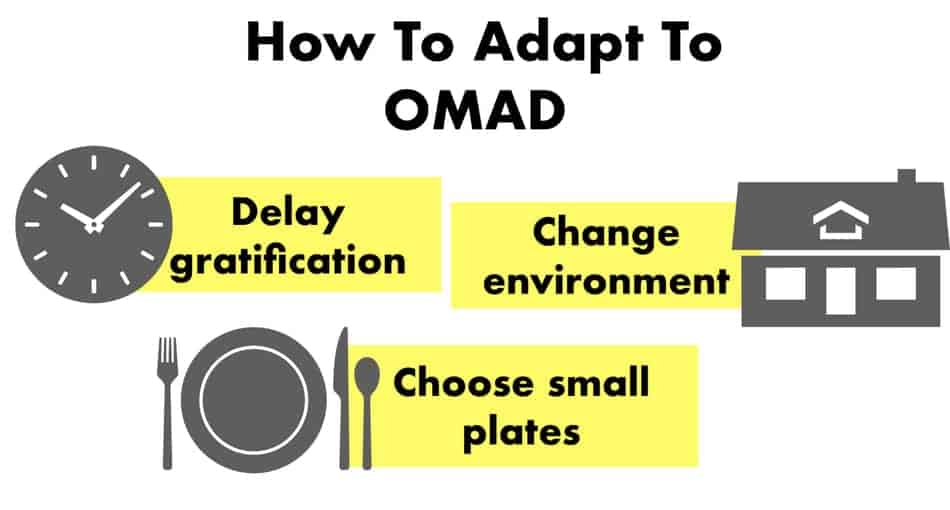
Tip #1: Use scale of 1 to 10
The scale of 1 to 10 is by far one of the best tools for putting everything and anything into perspective. It’s a reality check. Here’s how it works.
When you are facing any uncomfortable situation, when you’re about to let loose, when you feel overwhelmed and think that grabbing food seems like the only way out, simply ask yourself.
“On a scale of 1 to 10, with 10 being the most unpleasant and uncomfortable thing you could ever imagine doing, like let’s say getting a root canal or speaking on stage naked in front of thousands of people, where does this level of discomfort sit for me?”
Or try this.
“On a scale of 1 to 10, with 1 being ‘I’m not hungry at all’ and 10 being the most intense hunger pangs that I’ve experienced in my life’, where am I right now?”
Or something like this.
“On a scale of 1 to 10, with 1 being ‘I’m not interested at all, and 10 being ‘I would rather sell my kidney or cut my arm than give this up’, where does a glass of wine every night sit for me?”
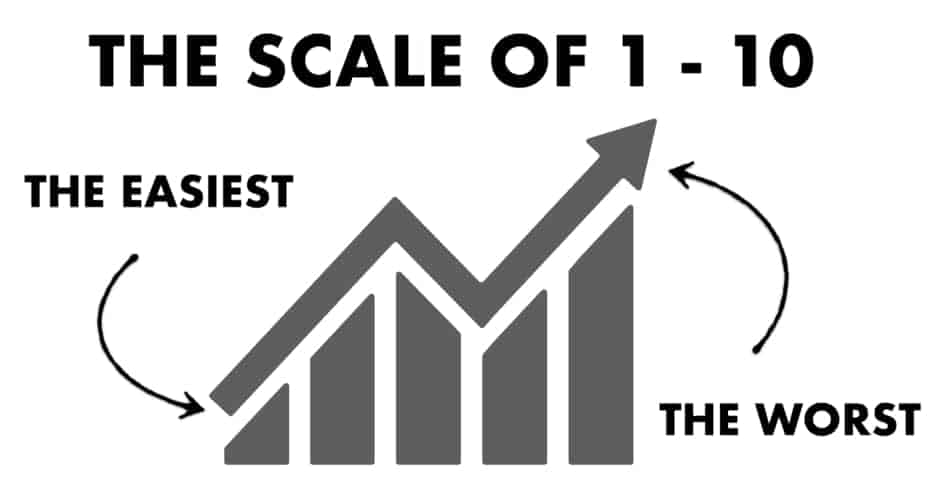
Make sense?
The reason the 1–10 scale is so effective it creates an honest comparison of the current situation. And turn your attention to the bigger picture. Because more often than not, any emotional sensations and feelings that we get initially seem as catastrophic and definite.
But once you put that into the perspective, all of a sudden the panic is gone and they lose their power.
That’s mental fitness.
That’s how you train your willpower. By doing so you get more bulletproof to the majority of distractions that come along the way. And the more you practice that skill, the better your willpower gets.
Tip #2: Put off gratification
Just imagine you’re 4-year old and you’re participating in an experiment. It’s a challenge, so to speak. You sat down in an empty room with a table and one marshmallow on this table.
Some nice lady told you that she’ll be back soon, and if you’ll wait, you’ll get two marshmallows for a reward.
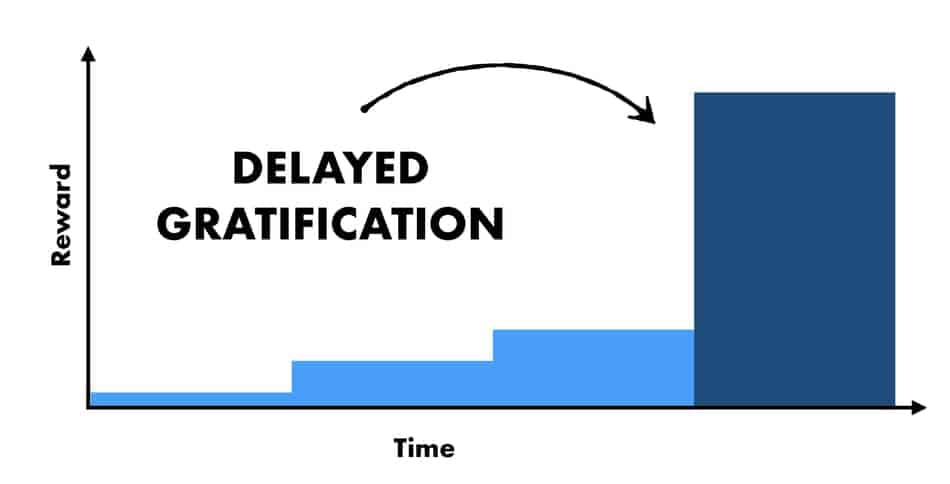
If you can’t wait until then, you can have one now, the one in front of you and you can eat it right now. As she goes out, inside of your 4-year old brain you feel the struggle.
To eat or not to eat.
It’s a battle of desire, self-control, ego, impulse, restraint, and gratification delay. This is how the world-famous Marshmallow Experiment been done in the 1960s by researcher Walter Mischel at Stanford. They asked kids to wait or to eat, while they were observing how 4-year olds react.
Here’s what happened.
Some of the kids ate the marshmallow right off the gate. Some kids waited a few minutes before they’ve eaten. But about one-third of the children were able to wait longer and got a second marshmallow (source).
To avoid the marshmallow temptation, some kids covered their eyes so they didn’t have to see them. Some turned away from the table and looked in the opposite direction. Others started to distract themselves, talked to themselves, sing songs, and played games with their hands and feet. Some tried to fall asleep.
The reward was, of course, two marshmallows instead of one. But here’s the best part. In the late 1980s, Mischel followed up with the kids he’d studied. The difference between those who delayed impulse and those who eat marshmallows immediately was dramatic.
Kids who couldn’t resist the marshmallow, later on in their life tended to have a more troubled psychological profile, they’re more prone to be seen as shying away from social interactions, they got easily upset and more likely to jealousy and envy, they’re stubborn, indecisive and overreact to irritations.
And, even years later, they’re unable to put off gratification.
On the other hand, kids who were able to restrain from temptation (now as adolescents) were more socially competent, emotionally stable, personally effective, able to cope with frustrations, and self-assertive.
They were less likely to crack under pressure, fall into pieces or freeze under stress. They embraced and pursued challenges even during tough times.
In other words, kids who were able to delay gratification in the marshmallow test turned out to be more successful in life.
In fact, this is one of the most essential skills you can learn. People who can stay focused on what they want, without getting distracted by any shiny object that pops right in front of them are much more likely to stay on track and accomplish their plans.
Tip #3: Organise Your Environment
Another great tactic to make sure you stick to OMAD and reduce setbacks as much as possible is by changing your nearest environment. Consider this.
According to research, on average we make more than 221 food-related decisions a day (source). Chicken or pasta? With or without sugar? Eat now or later? Large or extra-large?
Every time you pass the drive-thru you are making the decision to pop in or not. The more decisions you are forced to make, the less cognitive control you will have.
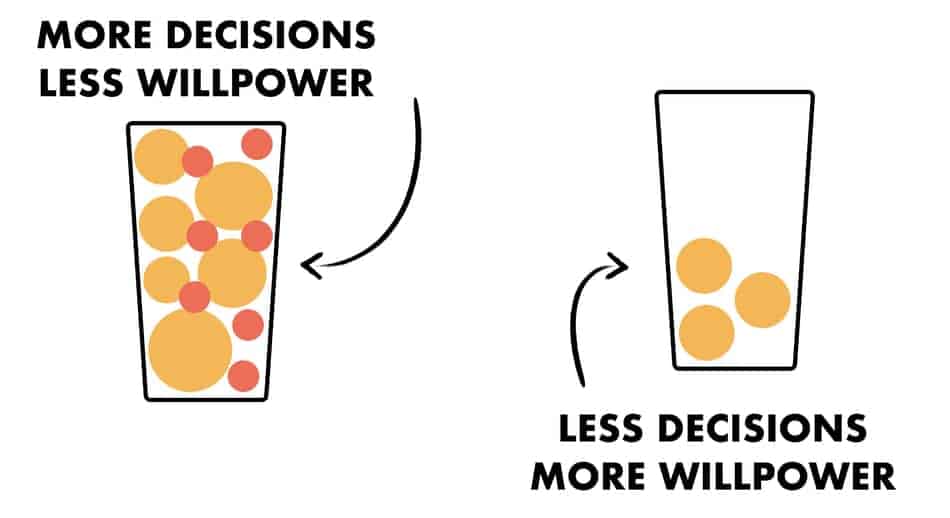
Because you can exercise your mental fitness and become great at delaying gratification. But the reality is that cognitive control aka willpower is not an infinite resource.
It’s like a battery, and sooner or later this battery will need some charging. It’s like building a house of cards. You may be really good at it ut one single mistake and Woah! Cards everywhere!
That’s why sometimes is easier to change your environment rather than change your mind.
For instance, you can build on your mental fitness all day long, trying to stay strong on OMAD and doing everything right. But if your coworker is keeping your favorite Krispy Kreme doughnuts on her desk every day, right in front of your face, then this will drain your batteries without you even knowing it.
Or if you’re constantly exposed to foods that are tempting at your home, if you keep on buying foods that you know at some point will lead to over-eating, you basically shooting yourself in the foot. We can build and exercise our willpower.
But unfortunately, willpower doesn’t last for too long. It’s ok to use it to overcome a single obstacle, but if you know the problem is the environment, that is something you can control.
Tip #4: Eat last
Always eat last around the dinner table. Everyone loves to lose the sense of time in those conversations and stories that we share at the dinner table. But it turns out that that it’s easy to lose track of how much food do we eat, too. Because we are so invested in the situation at hand, it’s easy to get distracted.
The bigger the group, the more likely we are to mimic the rest and eat more. Plus, we all have those manners and empathy that we wait until the last person finishes at the table. So we are more likely to snack more, refill or reorder the food.
In fact, if we gonna go one step further, all it takes is one more person to influence us to eat 35% more food than usual (source). And if we eat in a group of 7-8 people or more, we are likely to eat 96% more than usual (source).
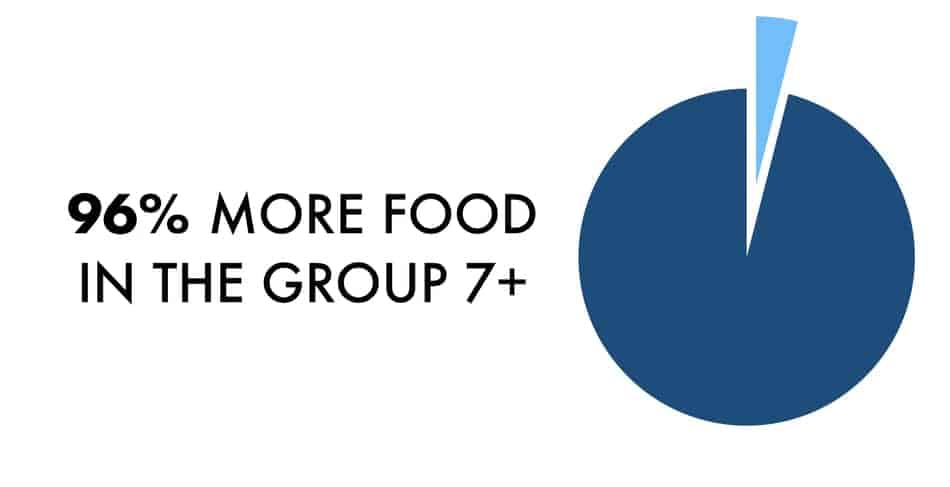
And I understand that you cannot go out and live alone for the rest of your life on Fiji Island. That’s why next time when you find yourself in a big group setting, try to
- Pay attention
- Start eating last
This will dramatically reduce your chances for eating more or snacking.
Tip #5: Choose smaller plates
There are people out there working round the clock to figure out what makes us eat more, spend more money, and spend more time in the restaurants or markets.
If you’re living in the Chicago area you may have heard about the restaurant called Spice Box. This place looks like a restaurant. It smells like a restaurant. And it sounds like a restaurant. But it’s not a restaurant.
It is a research laboratory filled with hidden cameras, hidden sensors, double side mirrors, scales under the table, and bottomless soup bowls. All under the careful eye of the researchers who are watching what you as you eat and how much you eat.
This in-house laboratory belongs to University of Illinois where they study everything about what makes people eat more and drink more.Here are some cool stuff they have discovered.
If you eat from big plates, big packages, and use big spoons, then we will naturally consume more food. Those sizes give us cues of how much is appropriate to eat. To show you what I mean take a look at the picture below.
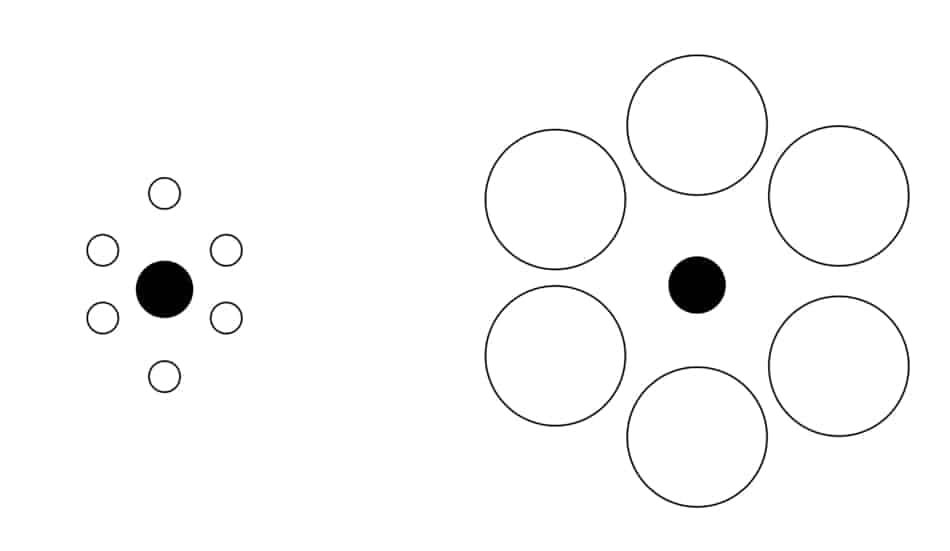
This is called sensory contrast illusion. Those black dots are exactly the same on both sides. However, the perception is different (source).
- On the left side, a black dot is surrounded by many smaller size circles. This creates the illusion of the black dot being massive.
- On the right side, a black dot is surrounded by many bigger size circles.
This creates the illusion of the black dot is much smaller. Now translate that to your food on your plate.
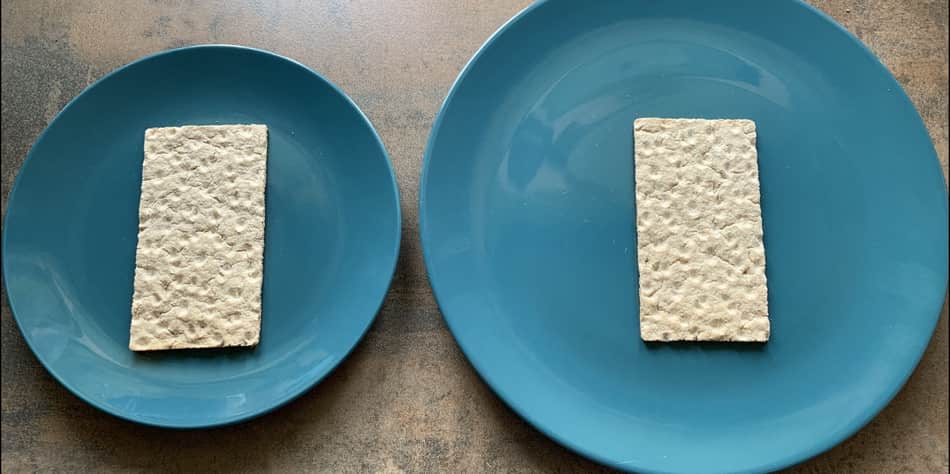
The bigger the plate you will use for your meals, it will create the illusion of small size. So unconsciously you will add more food because it will feel like there is not enough food. So bigger plates equal bigger portions. Use a smaller plate.
The same goes for the portion size.
If something looks big, we report being full for longer. For instance, if you make a smoothie, and you blend it a little bit longer, because of the extra air it will look puffier, and gets bigger. And guess what? In our heads, we will feel more satiety. Even if it has the same calories as the smaller smoothie.
Or if you add extra lettuce, greens, tomatoes, and onions to the quarter-pounder cheeseburger, so it looks like a half-pound cheeseburger, we will report feeling fuller for longer.
In other words, we believe our eyes, not our stomach.
Japanese have a phrase for it. Katachi no aji. This means the shape of a taste. The “We eat first with our eyes” phrase was coined by Marcus Apicius in the 1st century AD. This means we believe more in what our eyes see than what our stomachs feel.
Tip #6: Reduce variety of food
Another tip on how to stick to OMAD you can use is to reduce your variety of food. This phenomenon is called sensory-specific satiety.
Sensory-specific satiety refers to the declining satisfaction of food generated by the same food types, and the inclining satisfaction of food generated by exposure to a new flavor or food.
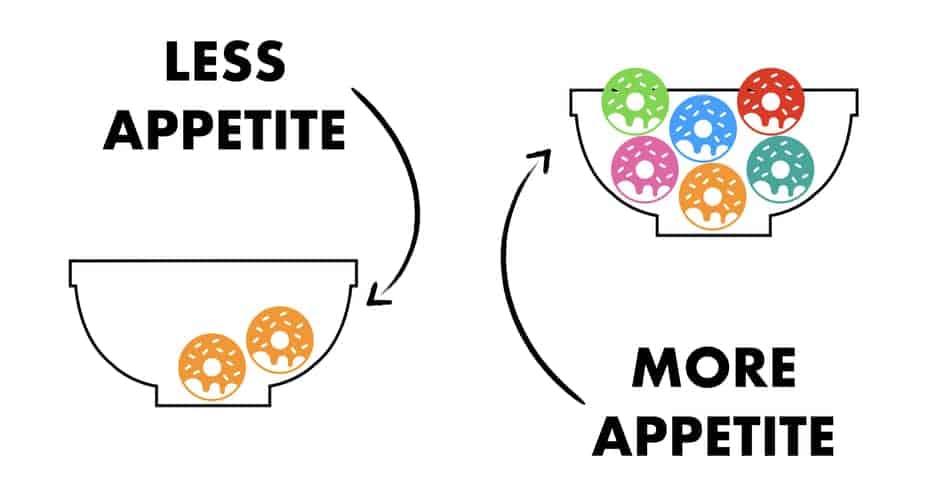
This means, if you just eat two things over and over again, your appetite will diminish almost immediately. In other words, we get bored. However, if you “sample” all different kinds of foods and flavors, your appetite goes up so you end up eating more (source).
For instance, if you have a chocolate brownie, you may get bored eating it just a half-way. But as soon as you add some whipped-cream, ice-cream, or toffee sauce, the variety of flavors went up so you are more likely to continue eating.
That’s why food buffet’s usually trick us to eat as much as we can because they offer more variety of foods.
This can be used in both ways. If you want to eat more, let’s say you want to trick your kids or even yourself to eat more fruits and veggies, all you need to do is to add more variety.
By doing so it will immediately increase the appetite, we get more excited and we eat for longer. But if you want to use that knowledge to reduce the food you tend to overeat, simply reduce the variety of it.
Tip #7: Out of sight, out of mind
Have you heard about the”see-food diet”? You see food and you eat food. That’s how your brain works. It’s like imagine alcoholic working in a booze store. It’s just a matter of time until his willpower evaporates. That candy dish that is sitting across your table is just waiting for you to reach out.
And is making you consistent effort to resist. The easiest solution is to move it, hide it or replace candy with something else that you don’t like.
If you can’t move it, go around it.
Tip #8: Make it more inconvenient
If it’s too easy to eat it, make it more difficult. This means any convenient foods make more inconvenient. In one study done by Stanly Schachter Ph.D., a group of researchers was inviting people to sit down in the office to fill out a quick questionnaire (source).
As soon as participants sat down, researchers pretended to be called out and told them to wait.
It will just take a few minutes, so wait here and please help yourself with the almonds from the desk. I’ll be back in 15 minutes”
Half of the time, the almonds on the desk were shelled. And another half of the time, they were unshelled. The results?
People with normal weight tend to eat 1-2 almonds regardless of them being shelled or not. However, obese people tend to eat almonds only if they were already shelled.
This means that some people are more influenced by “more hassle” when if comes to food choices. That’s one of the reasons why not many people cook and prepare veggies on a daily basis.
It’s too much work. You need to clean, cut, cook, clean after the cooking. They choose fruits more often. One day I asked my mother why she doesn’t eat oranges. She said to me because you need to peel them, so she doesn’t want to.
This may sound tragic, but it is really very useful information. Because we can use that in both ways.
- Make it more convenient for the foods that you need to eat more. If you find that it’s too much of an effort to prepare fruits and veggies, organize your kitchen to be hassle-free. Have a separate veggie “station” that will always be ready with a set of knives, chopping boards, and plastic containers.
- Make it more inconvenient for problematic foods. This means, move away from foods that always seem to give you more trouble. Hide them, put them somewhere where you don’t see them on the regular basis.
Take Away
When it comes to sticking to OMAD, always look at both sides of the coin. What you can do to make your willpower stronger and more robust.
So when an unexpected situation comes, you are prepared and you won’t crack under pressure.
But this also means how you can organize your own environment in a way that will support you, rather then prevent you.
Go Further with OMAD
This article is part of the How To Do OMAD, which I recommend you read.
In the following pages, I show you all the related aspects necessary to design and personalize your intermittent fasting approach to fit into your lifestyle.
Next: Click here to learn more about can you do OMAD long term
